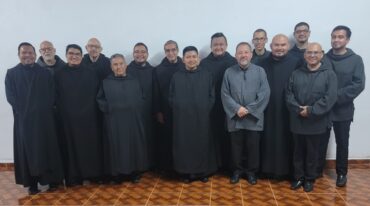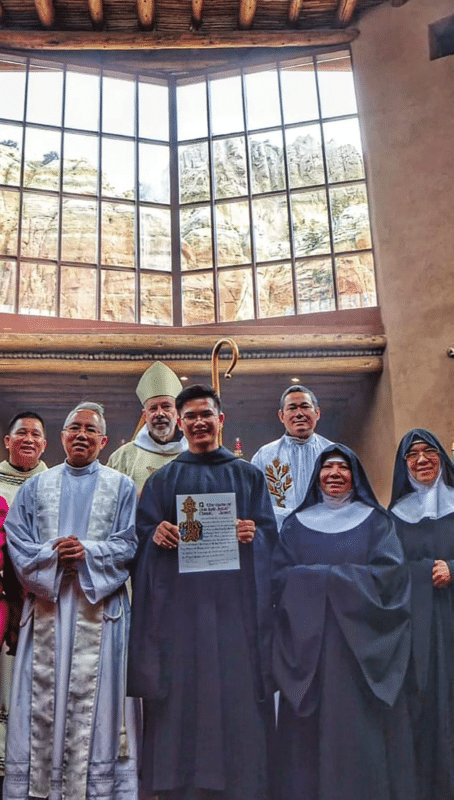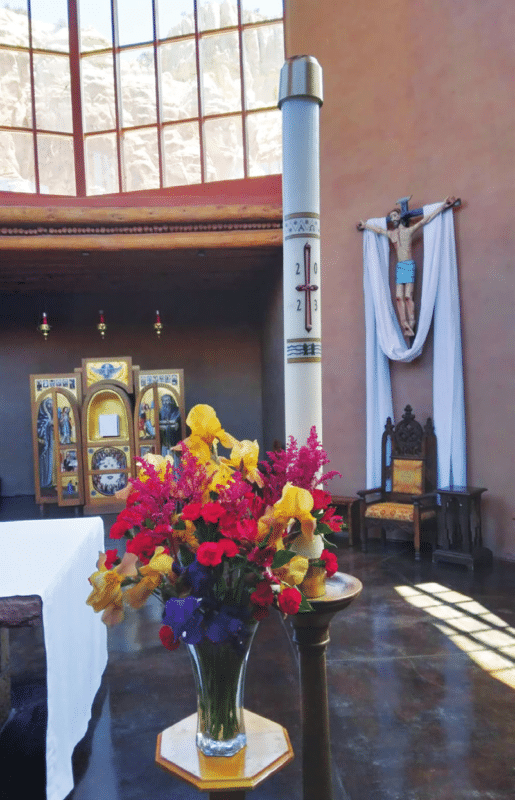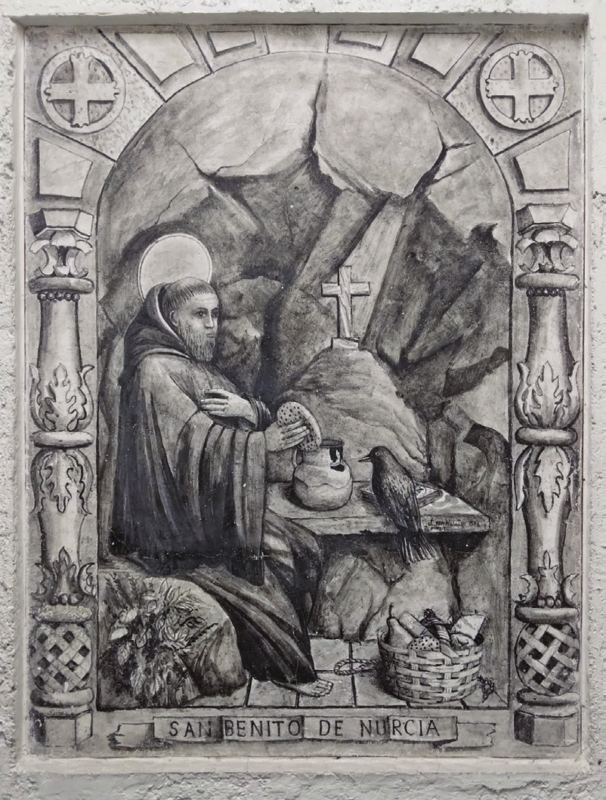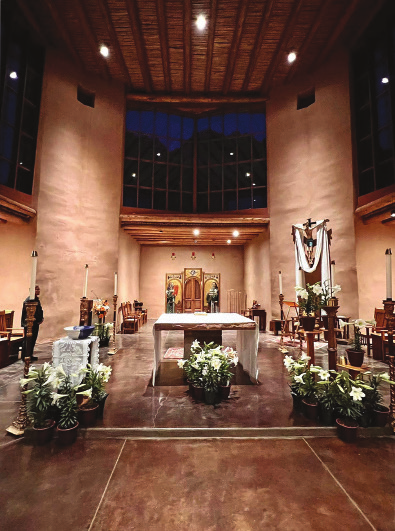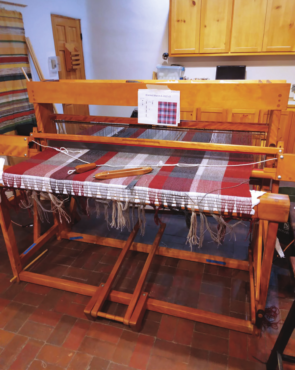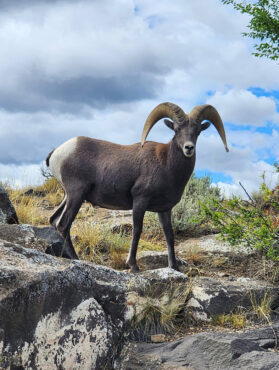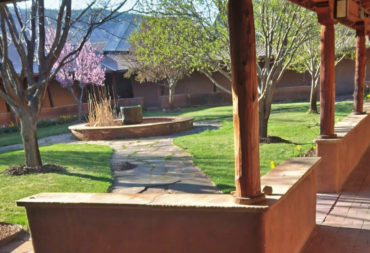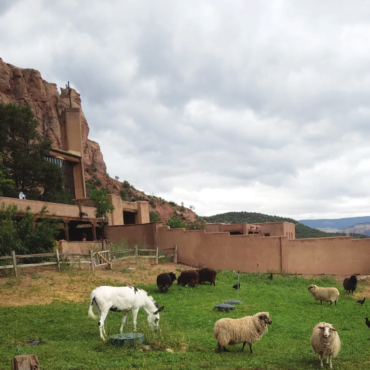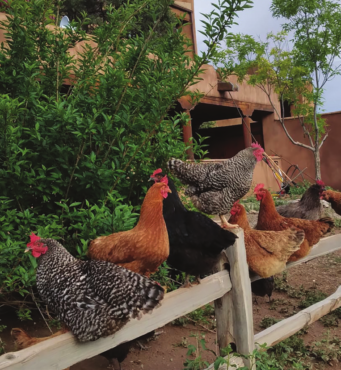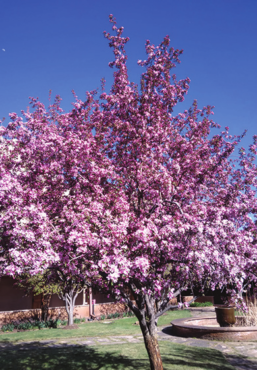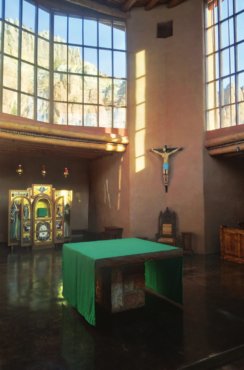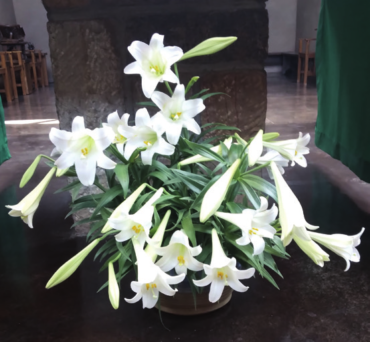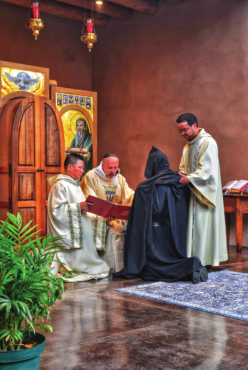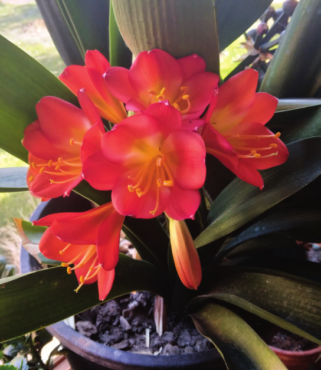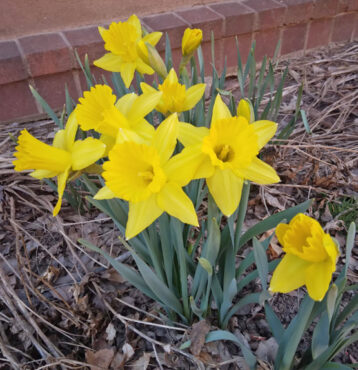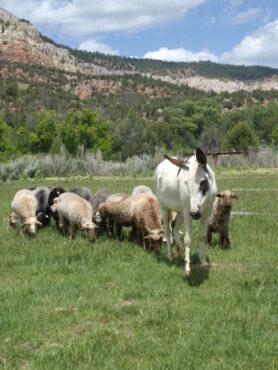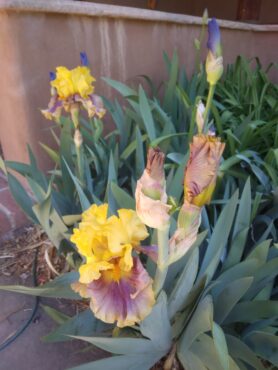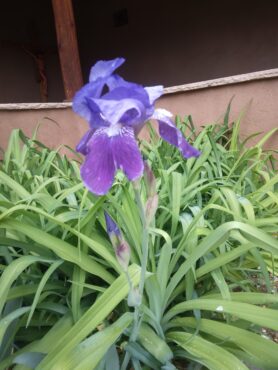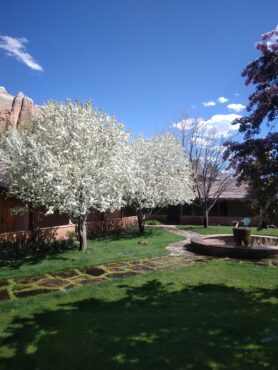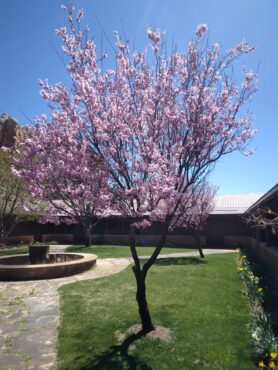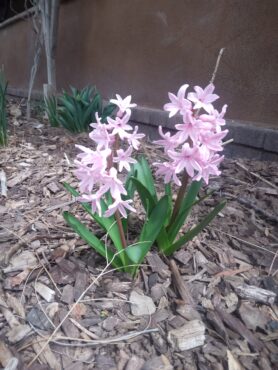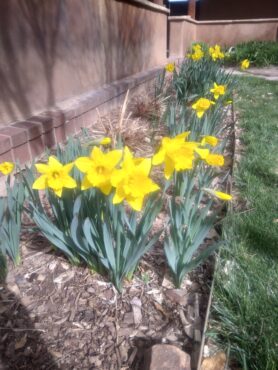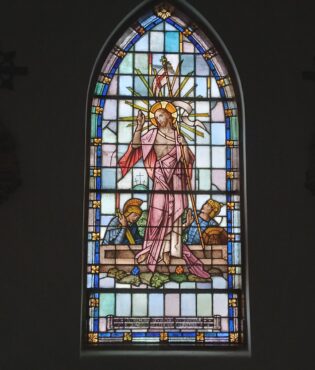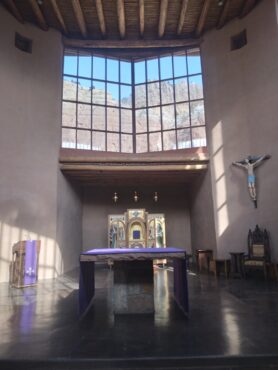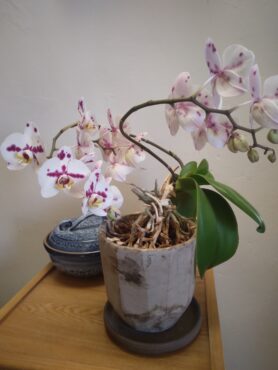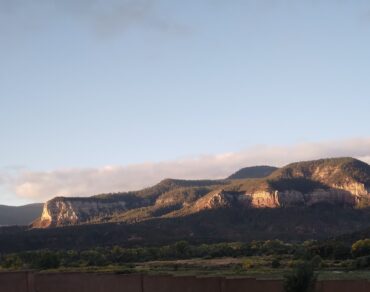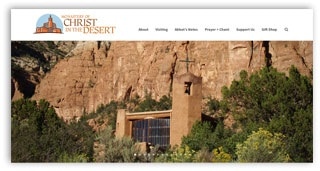Monastery News
If you would like to make sure you are kept up-to-date with our news, we encourage you to sign up for our newsletter.
July 20th: Anniversary at Santa Maria y Todos Los Santos
On Thursday, July 11th, the Solemnity of our Holy Father Saint Benedict, the monks of the Monastery of Saint Mary and All the Saints (Santa Maria y Todos Los Santos), in the Mexican State of Veracruz, a foundation the Monastery of Christ in Desert, celebrated its twenty-fifth anniversary of life, having been founded in 1999.
Today there are fifteen monks at Santa Maria y Todos Los Santos, including seven in solemn vows, four junior (temporary) professed and four postulants. They are blessed with young and energetic monks in their Benedictine life of prayer, work and hospitality.
The anniversary Mass at Santa Maria y Todos Los Santos on July 11th was held in the monks’ enormous outdoor but roofed church at 11:00 am. Abbot Christian of Christ in the Desert presided at the Mass and received the first vows of two novices, Brother Andres and Moises. Over a thousand people attended the Mass and enjoyed a meal afterwards.
The faith is alive and well in Mexico, and there are vocations to Religious Life and priesthood, thanks be to God.
During the recent stay in Mexico, Abbot Christian was also able to visit our monks at the Monastery of Nuestra Senora de la Soledad (Our Lady of Solitude), in the State of Guanajuato. There are now nine monks at La Soledad, professed and novices combined.
Visits to the Benedictine Sisters at San Benito Monastery in Mexico City, as well as Benedictine Sisters at Queretero, not too far from the monks at La Soledad, and Benedictine Sisters at Coyoacan in Mexico City, were on Abbot Christian’s itinerary. Distances are great between the various monasteries in Mexico, but fortunately an extensive and reliable bus system makes the journeys more comfortable.
Today’s photo is of the monks of Santa Maria y Todos los Santos on the evening of their anniversary celebrations.
“Ad multos annos” to all the Benedictine brothers and sisters in Mexico!
Abbot Christian and the monks of Christ in the Desert
July 7th: Easter Lilies in July
Each Spring we plant our Easter lilies in the cloister garden. They usually bloom at least once again in the later Summer or Fall. Some bloom from the previous year or years, such as the one in today’s photo. Enough lilies are blooming now that we should be able to make an arrangement of them for our monastery church this coming Thursday, July 11th, for the Solemnity of our Holy Father Saint Benedict, who lived from 480 to 547 AD.
On July 11th, our inimitable Brother Andre will celebrate 40 years of monastic profession and Brother Martino, our frequent chef, 14 years of profession. Monks for life! Ad multos annos.
We have been enjoying pleasant weather at present, with daytime temperatures in the mid-80s, but are praying the Summer rains kick in sooner than later. Some rain has fallen in recent weeks, but more is needed.
We keep all our family and friends in our prayers and are grateful for your prayers and support. Happy continuation of Summer.
Abbot Christian and the monks
Solemn Profession on Solemnity of the Sacred Heart
On June 7th, the Solemnity of the Sacred Heart of Jesus, our Father Zachary Nelson made his solemn profession and received the monastic consecration, becoming a permanent member of the chapter of monks of the Monastery of Christ in the Desert. Numerous family and friends of Father Zachary came from New Mexico, California, Spain and Mongolia to share in the festive day.
Father Zachary is a talented singer, cook, gardener and homilist, to mention the most obvious. He now also serves as Prior of our Monastery.
In today’s photo he is holding his document of profession of vows of obedience, stability and conversation of life, which we monks profess.
We have been greatly blessed with the solemn professions of four monks over the past four years, men who genuinely have vocations to our Monastery of Christ in the Desert and show good zeal for our Benedictine life of prayer and work. Ad multos annos to all of these men!
Please pray that others will come to take up the Benedictine way in this spectacular setting of the Chama Canyon wilderness. Thank you.
Abbot Christian and the monks
Summer Newsletter Monastery of Christ in the Desert 2024
FAITH OVER DOUBT
What is doubt? Another word for the concept is uncertainty or unresolved questions. Who of us doesn’t doubt sometimes or often? Questions such as: will my health hold out and will I be able to keep this job if it doesn’t?; how will my children end up?; will I ever reconcile with estranged relatives or friends?, and many more, may pass through our minds on a regular basis.
More profound doubts, such as: does God exist?; is there really a life after this one?; will I make it to heaven if there is an after- life?, may plague us as well. This should be no surprise or cause for alarm, when we have doubts or uncertainties. The bigger question is: what do I do with my doubts?
It should be a consolation that even great saints, such as Therese of Lisieux and Mother Teresa of Calcutta, grappled with serious doubt, yet in the process, never gave up believing that God is stronger than their personal uncertainty. As one anonymous author put it: don’t worry about not being strong enough before you begin. It is on the journey that God makes you strong.
This sentiment is echoed in numerous places in the Bible. Even the Blessed Virgin Mary expressed uncertainty at the Archangel Gabriel’s message that she would bear the Savior of the world. “How can this be?”, Mary asked. And she was given assurance that with God all things are possible.
The world we live in gives us plenty of reason to doubt about so much: the possibility of peace in the Middle East and in the Ukraine, the end of the covid pandemic, the future viability of the very planet we live on. In the face of such doubts and many others, we can understand- ably grow indifferent, bitter, angry or depressed. Yet there needs to be a reminder of the words of the Prophet Isaiah, conveying a crucial message from God: “Do not fear, for I am with you” (Isaiah 41:10).
But is that really enough to make us relax and trust? Maybe not always. However, as believers in a God who desires our good and our partaking of divine life, there needs to be a “leap of faith,” as it is often called, to have confidence that God is guiding the course of human events, even when that may seem far from the case.
Too easily, perhaps, we allow the evil that is evident in the world to prevail over the wider picture; that the majority of people are good, desire what is right and act justly. It is easy to forget this reality and become focused on specific disturbing situations in the world. That doesn’t diminish the seriousness of these situations, but it is so important not to let them overwhelm us.
How might we best do that? First, to cultivate a spirit of optimism rather than pessimism. This could be done, for example, by dedicating a period of time every day, a few minutes or longer, to praying specially for the conflicts and ills of our times, for God’s intervention to bring about a change of heart in those who are in armed conflict, or enlightenment for those trying to find solutions to disease and famine. That may seem like a feeble or even futile exercise, but as people of faith we believe in the power of prayer and should always be willing to engage in it.
Another important exercise might be to refrain from over-indulging in the media that is so focused on the ills of the world, rather than on all the goodness that exists. We all need examples of people and situations that en- courage and edify us in the common pilgrimage that we make from the cradle to the end of our earthly existence. Let’s look for those examples!
I recall being really uplifted by the 2000 documentary “Young at Heart: You’re Never Too Old to Rock,” about a Massachusetts-based choir composed of seniors (seventy and older I would qualify!), who were deeply dedicated
to bringing joy to others by their sung concerts of a wide variety of music. The film was funny and deeply encouraging at the same time. Would that all of us might be as enthusiastic as these elders in what they were doing, what we could even call “something beautiful for God”. Even if not specifically a “religious choir” by any means, the Young at Heart chorus was and is the embodiment of the words of Saint John Chrysostom that I often like to quote: “Glory be to God for all things!”
Yes, in our day and age there is plenty to “get us down,” to cause us to question the worth of living or hoping, but we are being called to resist the pessimism and promote the good, because we are people of faith. The old saying, “Better to light one candle than to curse the darkness” should never be far from our thoughts and practice, as we move through life, in good times and bad. We must place our trust in God and do our best to be people of faith, rather than of unbelief. May God help us in that vital work.
The theme of this Newsletter is “Faith Over Doubt”. May the words you read be cause for having faith and encourage you on your pilgrim way.
Abbot Christian Leisy, OSB
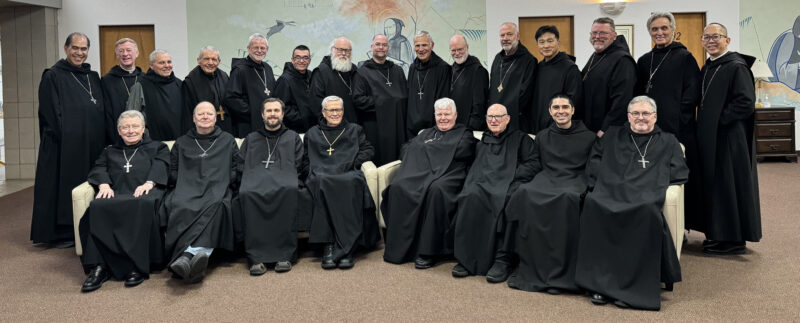
Abbot Christian with Other North American Abbots at Their Annual Meeting in February, this Year at Prince of Peace Abbey, Oceanside, California
DECEMBER 8TH: NEWLY PROFESSED BROTHER SAVIO
By Abbot Christian
Solemn vows of obedience, stability and conversion of life, and receiving the monastic consecration as a Benedictine monk, on the Solemnity of the Immaculate Conception, 2023.
In addition to his monastic community, a number of friends were also present for the Conventual Mass of Monastic Profession on December 8th at 11:00 am.
Distinguished guests included Brother Savio’s uncle, Father Benoit Vu, pastor of the parish of Saint Joseph in Springer, New Mexico, approximately four hours from us.
Only an hour away is the parish of San Juan Nepomuceno in El Rito, New Mexico, whose pastor, Father Joseph Dao, was present too. El Rito is the location of a medical and dental clinic that we regularly visit.
After the 11:00 am Mass, lasting about an hour and a half, at approximately 1:15 pm we enjoyed a splendid Vietnamese meal prepared by our Brothers John Baptist, Martino and Prior Bonaventure, as well as oblates Tom and Angie Nguyen.
We rejoice in the continued growth of our monastic community and for Brother Savio’s commitment, and appreciate your prayers for Brother Savio, for all his needs and intentions
CELEBRATING THE LITURGY
By Abbot Christian
For the last few centuries, at least in Europe and the Americas, Catholics have opted to sing what we call “hymns” at Sunday and daily Mass (the Eucharist). The texts of the hymns are sometimes from the Bible, but not always, and the melodies are often familiar tunes (frequently of German or French origin), or else original musical compositions, by Catholic and non-Catholic musicians. Singing a hymn at the begin- ning of Mass, as well as at the Offertory, Communion and conclusion of Mass, has become the staple of what is “sung at Mass,” rain or shine. While hymns at Mass are not forbidden, the Church is actually asking something else of the faithful.
For centuries the Church has assigned specific Bible texts to accompany the Entrance (also called the “Introit”), the Offertory and the Communion at every Mass. Especially since Vatican II, with its emphasis on Catholics knowing the Bible better, these Scripture texts have been deemed to be the most appropriate words for the various moments at Mass.
Today chant-based music is provided in the Roman Missal for the various English words of the priest and the people at Mass, but no music is provided for the Entrance, Offertory and Communion texts, or “antiphons,” as they are officially called.
Is there a resource available for singing at Mass using the biblical texts assigned by the Church?
At Christ in the Desert we have found the answer to that question in the work of the Benedictine Father Samuel Weber, a monk of Saint Meinrad Archabbey in Indiana. Father Samuel has taken the official English texts from the Roman Missal for every Sunday and weekday, as well as for Solemnities and Feasts and Seasons of the Church throughout the year (Advent, Christmas, Lent, Easter), and adapted traditional Gregorian chant melodies to the Entrance, Offertory and Communion antiphons.
Father Samuel’s work is a boon to our monastic liturgy, and is also used at numerous English-speaking parish Masses, and by other religious communities as well. Father Samuel’s 2010, The Proper of the Mass for Sundays and Solemnities: Chants for the Roman
Missal in English, is our “go to” resource for Ordinary Time and Solemnity Masses. This handsomely produced volume is available in the USA through Ignatius Press.
Father Samuel has completed two other valuable volumes of Mass music, one which covers each special Season of the Liturgical Year, that is, Advent and Christmastide, Lent and Eastertide, and the second volume for the Saints of the Church. A fourth volume also exists, for Votive (Ritual) Masses. These volumes are available at Father Samuel’s website: Sacredmusicus.Wordpress.com
Along with Father Samuel’s Mass books that we use each day (just one of his volumes is needed for any given day), we also use the slim volume, called the Kyriale, from the Benedictine Abbey of Solesmes in France, with every Kyrie (Lord, have mercy), Sanctus (Holy, Holy) and Agnus Dei (Lamb of God) needed each day, as well as the Gloria (Gloria to God) and Credo (the Creed), which are used on Sundays, Feasts and Solemnities. The Kyriale is available for purchase through GIA Publications (Gregorian Institute of America), in Chicago.
We are very indebted to Father Samuel Weber for the noble simplicity of his work, which enhances our celebration of the Mass each day.
DOUBT IS ALWAYS THERE
Short Fiction
By Brother Chrysostom
Spring semester 2009 would decide her future in the department. Hannah Walsh struggled in the History Department as an instructor for the past three years. Her student evaluations improved, but she failed to attract numbers of students for larger class sizes— what tenured professors like Professor Sterling- White did effortlessly. Her fellow untenured col- leagues encouraged her. She appreciated their esprit de corps, especially from Br. Placid and Dr. Stigler, both medievalists new to the history department.
Sadly, she could pull in neither the number of students nor the high evaluations that would strengthen her case for a tenure-track position at Benedictus College, nestled amongst the cornfields and storied golf courses of southern Pennsylvania.
Her opportunity for redemption came astoundingly. Br. Enoch, an éminence grise in the Traditions of Monasticism Department at the college, had to take a leave of absence due to an unexpected appendectomy. Were he a younger monk, say 60, he might have recovered in time to start and complete the spring course. But Br. Enoch was a strapping 87, spry, yes, but not as resilient as he used to be when monks filled the choirs in the vast university church and numbered in the 400’s decades ago.
Because the other professors in the department were juggling heavy course-loads, while some were scheduled to teach at St. Victor College in North Dakota, they chose Dr. Hannah Walsh, reluctantly, to pull up the slack and teach the Introduction to Monasticism 101 course that many freshmen took in their second semester, along with a sprinkling of some upper classmen who needed a ‘filler’ class to complete a graduation requirement. The department heads in History and Theology agreed to give the struggling Dr. Walsh a shot at a popular class.
Having little time to prepare a syllabus, she borrowed Br. Enoch’s with the permission of Dr. Stanton, her department head. She tried to make the course offering enticing, at least to herself first, but the story of monastic traditions starting with Simeon and Anna, then moving onto the Desert Fathers, then to Saint Benedict’s life and to the great monasteries of Europe, Charlemagne and the Frankish Empire, Cîteaux Abbey, the Abbeys of Montecassino, Cluny, and Mont St. Michel seemed dry and lifeless to her. How would she bring these great monasteries and their famous abbots to life for freshmen whose main goal in class would be to ‘like’ on social media the most sensational clip from last weekend’s dorm party? She needed a hook.
Three days before the commencement of the spring semester the hook came to her: a concluding field trip to the Met Cloisters Museum in Manhattan. She hadn’t had time to add it to the syllabus she submit- ted online weeks ago, so she thought it would be the first reveal of the new semester.
Only five students populated the small classroom assigned to her for the class. Not enough to make a class, in the judgment of Fr. Butler, the Provost. Tenure was not to be, she thought. She was about to dismiss the class, thinking it would be cancelled, when Earl, a senior pre-med, sauntered into class and sat down in one of the desks in the back. His grey plain shirt with white long underwear peeping above the collar, faded blue jeans, unlaced Timber-
land boots with fleece lining, disheveled hair tucked quickly under a tight black skull-cap announced to the five freshmen the return of the ‘king’. Hannah quickly went over the syllabus with the six students required to make the class. She mustered as much enthusiasm for the subject matter as she possibly could, and near the end of class, with raised hands, gave the announcement about the field trip to the Met Cloisters at the end of the semester. The freshmen looked up from their laptops—and social media—and stared at Hannah in joyous disbelief. Even King Earl lifted his drowsy head from a quick catnap to think about the proposition: a day trip to the Big Apple.
Oh, yeah!
The semester passed quickly. Hannah discovered early on that she really learned a subject when she had to teach it. Hannah became engrossed in monastic traditions and history; her students’ interest was ignited by her curiosity. The accounts of Guillaume Marlot and the construction of the Rheims Cathedral; double monasteries such as Barking Abbey, which followed the Gallic tradition of separation of the sexes with one exception: under Hildelith, abbess of Barking, both monk and nun burials were combined into a single mass grave. And, of course, the juggernaut Abbey of Cluny, which created a large, federated order in competition with the order of kingdoms in their day. Readings from Henry Adams’ Mont Saint Michel and Chartres stoked the romantic appetites of the eager freshmen, Josie, Charles, Brittany, Marie, and Mark for the architecture they would be experiencing at the end of the semester on the field trip. Hannah could not believe, in spite of her rocky start with the department, that she was actually getting paid to teach this wonderful course!
King Earl turned his nose up at the enthusiasm of his teacher and her acolytes. He never bestowed upon a class discussion the gift of his opinions. He exiled himself from most classes and abdicated on most assignments. He reclined in the back of the class room, his long legs finding ample space to stretch between two desks in the penultimate row. When he did present himself, like a force of nature, the mousy freshmen would become muted, as if they were afraid that he would ruin gaiety because it did not include him or was not sanctioned by him. Minutes into class after his auspicious appear- ance, Hannah would draw the focus back to herself and the course material, and the learning would resume.
King Earl, however, for the field trip did find his way into the school van that they would drive to New York City
at the monastic hour of 4:00 am. Over a morning, rural Pennsylvania changed into rural New York, and changed again into urban New York City. They arrived at the Met Cloisters in Washington Heights in Upper Manhattan, over- looking the Hudson River. The museum featured parts of several European monasteries, which had been dismantled, transported, and rebuilt in New York. Frescoes, tapestries, sculptures, stained glass, and religious images evoked the spirit of the medieval monasteries reconstructed at the end of the A train line.
After lunch and a few hours to explore the museum, the trip was deemed an undeniable success. The students talked about it most of the way back during the drive to campus. King Earl at shotgun in the van and driver Han- nah found themselves the only passengers awake during the last two hundred or so miles from campus. King Earl seemed moved by the experience, but Hannah had difficulty believing his interest, given his egregious absences and slapdash work. When she found the courage to ask him about the disconnect between his behavior and his apparent interest in the subject matter, he simply pulled his black skull-cap down over his eyes and proclaimed through a melodramatic sigh:
“Healthy doubt, Prof. Hannah. You can’t always believe what you see,” King Earl said.
During final exams week and after impassioned cajoling from King Earl, she allowed him to take the final exam, although he should have failed the class on attendance alone. He needed to pass the course. She needed his evaluation, moreover, to make this course and raise her stock in the eyes of the department.
The evaluations were proctored after the final exam on the fol- lowing class. King Earl was absent from class. The class did not make with only five evaluations, despite the praises of her cherubic freshmen. She dolefully graded the final exams and submitted her final grades, which she thought might indeed be her final grades at that college. She gave King Earl a passing grade so as not to dash his medical-school aspirations. She had no expectations of returning to teach at the college the next semester.
It is Spring Semester 2018. Professor Hannah reaches into her mailbox in the department mailroom, where hers is above those of the newly hired instructors in the department. She walks a short distance from the mailroom to her spacious office with a window facing the quad and the rural Pennsylvanian farmland.
It is a beautiful spring afternoon and the sun strikes her face with an intensity that holds her in a calm bliss as she sinks into her high-back chair behind her large desk. She ruffles through the interdepartmental mail, publishing-house junk mail, and errant announcements for upcoming lectures, and finds the postcard.
She extracts the card and lays the balance of the mail upon her recently received Fr. Erskine Touhy Award for Outstanding Classroom Teaching and Student Engagement. The photo side is of some ancient monastic cloister hallway she doesn’t recognize. She turns the card over and reads the regal script:
Hey, Prof. Hannah,
My wife, new daughter, our parents, and I had a great visit to the Cloisters. I remember you brought me here first!
Best, Earl Crammer, M.D.
60TH ANNIVERSARY OF THE MONASTERY
This year marks the 60th anniversary of the founding of the Monastery of Christ in the Desert, which took place on June 24th, 1964.
On that day our founding Prior, Father Aelred Wall, and co-founders Fathers Placid Cormey and Basil DePinto inaugurated monastic life in the Chama Canyon wilderness of Northern New Mexico.
We are grateful beyond words for the foresight and courage of the monks who began our monastery and who laid the groundwork for future generations of monks, retreatants and day visitors to come to this place we call home, where we strive to glorify God in our daily round of Benedictine monastic life.
Each day at Mass we pray for those who have “gone before us marked with the sign of faith,” that is, all the Faithful Departed. These include two of our founders (Father Basil DePinto is still alive!), as well as others who have been members of our community in the past.
These and many other family members, friends, benefactors and oblates have assisted in keeping our Monastery afloat, where we aim at implementing the words of Saint Benedict: “Let them prefer nothing whatever to Christ.” ✠
May 26th: Peaceable Kingdom
Currently our “guard-donkey,” Matty, has thirteen Navajo-Churro sheep to watch over and protect. Natural predators exist in our canyon, and traditionally ranchers have used dogs, llamas and donkeys to guard their sheep. Human shepherds still exist, of course, but they are rarer in this day and age.
Our sheep and donkey have abundant pastureland to enjoy and remain hale and hearty, as seen in today’s photo below. They also have a spacious covered shelter in which to take refuge in the colder months or when it rains or snows.
Matty the donkey belongs to the breed called the “American Spotted Donkey,” and was born on our property the day before Thanksgiving nearly five years ago. Fortunately, she has never had an ailment or injury her entire life and is a very “mellow” creature.
Donkeys (also called burros) are typically hearty animals and we know have been on our planet for many millennia, surviving in a variety of climates.
Often considered “beasts of burden,” that is not the case with our donkey Matty, who lives a tranquil life in the midst of desert beauty. We have the sheep to harvest wool for spinning, used for weaving and other fiber arts projects. As far as we can tell, Matty’s very presence amidst the sheep automatically wards off predators.
With this comes our greetings and assurance of prayers. Please keep us in your prayers. Thank you.
Abbot Christian and the monks
May 19th: End of Easter Season
With the celebration of Pentecost Sunday, observed this year on May 19th, the Easter Season draws to a close and the liturgical season called “Ordinary Time” begins anew on Monday, May 20th. Ordinary Time, which extends until the beginning Advent, when we prepare for Christmas, begins on December 1st this year. That may seem like a long way off, but as it goes, Advent will be here before we know it.
Stately irises (see the photo below) continue to bloom in our cloister and Guesthouse gardens, and are being used to decorate the monastery church. In the coming days peonies in a variety of colors will be in bloom. They too are excellent for floral arrangement in the church.
During the coming weeks we will be celebrating the Solemnities of Corpus Christi (the Body and Blood of Christ) on June 2nd and the Sacred Heart of Jesus on June 7th. Noteworthy liturgical commemorations of some great saints of the Church will include the Birth of Saint John the Baptist on June 24th, the Solemnity of Saints Peter and Paul on June 29th and the Solemnity of Saint Benedict on July 11th. These are always festive occasions at the commencement of Summer.
Anyone following the Catholic Liturgical Calendar has much to celebrate in the course of the year, and we at the monastery do our best to “glorify God” at all times, as Saint Benedict encourages his monks to do. Hence, we have a rich life of prayer in common at the celebration of the Conventual Mass each morning and the chanting of the Divine Office in church throughout each day, beginning at 4:00 am Vigils and ending with Compline at 7:15 pm.
We keep you in our prayers and we are grateful for yours.
Abbot Christian and the monks
May 7th: Ladybug
Ladybugs in a garden are always a good sign. Why? Because they are natural predators of aphids, tiny insects that feed on plant sap, which ultimately does harm to plants. The ladybug has been called a “natural insecticide.”
Today’s photo is of a ladybug among the peonies that will soon be blooming in our cloister garden. She may have to do some searching for aphids, as our plants are, we believe, “aphid-free,” but she’s on the lookout nonetheless. Aphids are often invisible to the naked eye, but not to ladybugs!
We have been enjoying pleasant weather of late, though having intermittent gusty winds as well. The change from Winter to Spring is pretty much completed and being enjoyed, though less so by allergy sufferers among us.
With this comes our greetings and assurance of prayers. Please keep us in your prayers. Thank you.
Abbot Christian and the monks
May 3rd: Italian Iris
Nearly four decades ago a friend of ours brought us a bunch of blue iris bulbs from a monastery in northern Italy. The bulbs were planted here and around 1996 were transferred to our new cloister garden in the middle of our living quarters. 1996 was the year the cloister was blessed and dedicated.
The “Italian iris” have been doing well ever since, though in recent years the orange day lilies have been dominating the shared space with the iris. More clever gardeners than us would probably not let this happen, but we have never taken the time to equally distribute the iris and the lilies.
In any case, all the flowers that bloom in our garden each Spring and Summer are always beautiful. Soon paeonies of various colors will again be dominating the cloister flower beds. They are ideal flowers for making arrangements to place in our monastery church.
We are having very pleasant weather these days and of course are praying that needed rain might still arrive sooner than later. For the moment the situation is not dire, as early Spring snow and rains were helpful, but we always hope for more.
Maybe there is an analogy here with longing for the Lord in our lives. We can never get “enough” of God’s grace for our spirits, and need to remain receptive for the daily work of our Lord in our lives.
Be assured of our prayers and we are grateful for yours.
Abbot Christian and the monks
April 30th: Greenhouse Growing
Our new greenhouse is fully operable, under the watchful care of Father Zachary, assisted by others as time permits. We are growing vegetables and flowers there, which will be harvested throughout the Summer and Autumn months. Even in the winter we should be able to grow produce in the greenhouse.
We are especially indebted to the Catholic Foundation of the Archdiocese of Santa Fe for their assistance in making the greenhouse project possible.
The current warmer weather means other outdoor projects are being tackled, including irrigating pastures, shearing sheep, keeping the chicken house clean, gathering fallen branches and planting the lilies that decorated our church for the first weeks of Easter. As one Sister of the Love of God in England liked to say: “Keep on going on.” That’s what we try to do!
Our greetings and prayers as we continue the celebration of the Easter Season.
Abbot Christian and the monks
April 28th: Fifth Sunday of Easter
Currently we are getting some gentle rain, which of course is always welcome, as it reduces the risk of forest fires and nourishes the earth. In addition, the perennial Spring flowers, such as daffodils, tulips and hyacinths, benefit from the rain and are blooming nicely in the cloister garden.
Our Brother Chrysostom is now completing the “Monastic Formators Program” in Rome, which lasts almost three months. Brother will be returning here in early June. He has been living at the international Benedictine headquarters in Rome, the Abbey of Sant’ Anselmo on the Aventine Hill, with twenty-five other monks and nuns from around the world who are working in the area of forming new members in their respective monasteries.
Father Zachary is preparing for solemn vows in June, and he will be the fourth monk to make solemn vows here over the past four years. We are delighted with these solid additions to our monastic chapter of solemnly professed monks, and are expecting some men to begin their time of initial formation as observers and postulants soon. Please keep all of them in your prayers. Thank you.
As we continue our fifty-days celebration of the Lord’s Resurrection, we assure you of our continued prayers. Christ is Risen! Truly He is Risen!
Abbot Christian and the monks
April 24th: Spring Sustained
We are enjoying an abundance of new life in the Chama Canyon wilderness. Today’s photo shows one of the signs of this, three flowering trees and one “still on the way” in our cloister garden.
The warm daytime temperatures indicate that there is unlikely to be any more chilly temperatures at night, even though our buildings are heated in the colder months.
The Sacred Season of Paschaltide (Easter) continues, and we are now in the Fourth Week of Easter. We are still singing many “Alleluias” in the course of day at the Divine Office and at the Conventual Mass. Alleluia is the characteristic cry of Easter, translated as, “God be praised,” but fortunately left in its original Hebrew form: “Alleluia.”
We assure you of our daily prayers and of our gratitude for all who do good for us. Please keep us in your prayers. Thank you and God bless you.
Abbot Christian and the monks
April 15th: Spring’s Arrival
We are always delighted with the arrival of Spring. The fact that it coincides with the liturgical season of Easter is an added plus.
Today’s photo is from our cloister garden, the area where we monks have our rooms, technically called “cells”. The fountain in the middle of the courtyard, the six deciduous trees, the green lawn and the now-blooming flowerbeds, all make the garden a real oasis in the desert.
At another location on our property, our newly completed greenhouse has been planted and we await a wide variety of vegetables and flowers in the coming months.
The warmer weather also means various outdoors projects can be pursued, such as landscaping, clearing brush and fallen branches, as well as tending to our pastures and making needed repairs on some of our buildings.
At the same time, our daily round of prayer and hospitality continues, whatever the weather. The heart and soul of our life is striving to glorify God in whatever we do. Of course, that is the call for all, as the psalmist exhorts: “If today you hear God’s voice, harden not your hearts.”
With assurance of our prayers and always grateful for yours,
Abbot Christian and the monks of Christ in the Desert
April 9: Easter Continues
We are still basking in the light of the mystery of the Lord’s Resurrection.
Flowers are blooming in the cloister garden, trees are beginning to bud, the grass is turning green again and the weather is decidedly Spring-like.
The monks are staying well, thanks be to God, and we carry on the usual routine of ora et labora (prayer and work), in the midst of desert beauty in the Chama Canyon wilderness. You are in our prayers and we are grateful for yours. Thank you for your support.
Happy Second week of Paschatide!
Abbot Christian and the monks
Blessed Paschaltide!
We continue our celebration of Paschaltide (Easter!), coinciding with the arrival of Spring in the Chama Canyon wilderness. The triumphant Alleluia is chanted throughout the day, both at Mass and at the Divine Office (Opus Dei).
Today’s photo is from our cloister garden, where daffodils are blooming like mad at present.
To all our families, friends, benefactors and oblates, a blessed and holy celebration of the Lord’s Resurrection!
Abbot Christian and the monks
Easter Octave 2024
Easter Day was on Sunday, March 31st, but the Church continues to celebrate this Great Day with an Octave, that is, eight days of rejoicing to prolong the joy of the Lord’s Resurrection. And after that, we still hold on to the Easter festivities right up to Pentecost Sunday, this year on May 19th.
In addition to our liturgical celebrations, we are enjoying Spring-like weather these days in the Chama Canyon, with plenty of sunshine and warm daytime temperatures.
To all our families, friends, benefactors and oblates, we extend our greetings in this Holy Season and keep you in our prayers. Please keep us in yours.
Christ is Risen! Truly He is Risen!
Abbot Christian and the monks
Easter Sunday 2024
Christ is Risen! Truly He is Risen!
Happy and holy Easter to all our families, friends, benefactors and oblates!
Abbot Christian and the monks of Christ in the Desert
Holy Week Schedule of Services 2024
Good Friday, March 29th: Afternoon Liturgy of Good Friday at 3:30 pm
Holy Saturday, March 30th/31st: Solemn Vigil and Mass of the Lord’s Resurrection at 12 Midnight
Easter Sunday, March 31st: Easter Day Mass at 11:00 am
March 4th: All You Winds, Bless the Lord
A sure sign that Spring cannot be far off in this part of the country is the arrival of regular daytime winds, sometimes gusting to twenty or more miles per hour.
The beautiful canticle from the Old Testament Book of Daniel, chapter 3, is an invitation to recognize how God is glorified in creation, including the sun and moon, rain and wind, ice and snow, to mention just a few of the many natural features of God’s handiwork, that is, the earth and all that surrounds it.
We continue the forty days of Lent with its usual focus on prayer, fasting and doing good. It tends to be a quieter time, with few big liturgical celebrations during these weeks.
We wish all our families, friends, benefactors and oblates a blessed continuation of this holy season leading to the great mystery of the Lord’s Resurrection and its annual accompanying celebration.
Be assured of our prayers and please keep us in your prayers. Thank you and God bless you.
Abbot Christian and the monks
February 20th: Brother Orchid
An easily overlooked but worthwhile black and white film from 1940 is called BROTHER ORCHID, starring Edgar G. Robinson. It tells the fictional tale of mob boss Little John Sarto, played by Robinson, who gives up his turf to another mobster, played by Humphrey Bogart. Five years later Sarto tries to take back his turf, but in the process he falls victim to a trap and left for dead. Fortunately Sarto survives the trap and flees, ending up at a monastery of monks, whose principal source of revenue is selling fresh flowers.
Taken in to the monastery by the Brother Superior, Sarto gradually begins to realize the futility of his criminal ways and makes some drastic life changes.
The film clearly carries some important Lenten themes and the name “Brother Orchid” is made evident by the end of the story.
Today photo is of a currently blooming orchid at our monastery.
Be assured of our prayers and we are grateful for yours.
Abbot Christian and the monks
February 14th: Lent Has Begun
The Holy Season of Lent has begun and we monks, along with all Christians, see it as a special time of prayer, fasting and good works. Saint Benedict says a monk’s life should always have about it a “Lenten character,” implying some degree of asceticism and sacrifice year round, but especially so during the forty days of Lent. Why do we do this? In order to draw closer to God and to to build up the Body of Christ on earth.
The reception of ashes on Ash Wednesday takes place during our morning Conventual Mass, which ended at about 7:00 am. At our meeting at 8:30 am, we listen to a chapter of the Rule of Saint Benedict and finalize the morning work, then we each receive from the Abbot a book from the Bible for our Lenten “lectio divina,” or “holy reading.”
This year we monks will be reading, meditating, praying from and contemplating on the New Testament “Letter to the Hebrews.” We invite all who read this to do likewise. The Letter to the Hebrews is a wonderful text with the general theme of salvation won for us by Jesus Christ, true God and true Man, who gives us grace to avoid sin and to draw nearer to God in holiness. That is our Lenten task, a kind of pilgrimage toward our proper and lasting home in God’s Church now and in Heaven for ever.
A blessed and holy Lent to all. You are in our prayers and we are grateful for yours.
Abbot Christian and the monks

